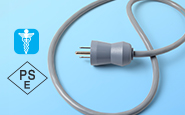More Information on Switches and Voltage Selectors
Switches
The rocker power switches in this section are intended for use in mains power applications on equipment, which will be sold globally. They carry agency approvals, current ratings, and contact spacings that are appropriate for global applications and they fit in industry standard panel cutouts. In all cases, they are the double pole, single throw switches which allow simultaneous switching of both current carrying conductors as required in most international standards and accepted by North American standards agencies.
Rocker actuators are increasingly popular on power switches because they protrude very little beyond the panel on which they are mounted. They are also very practical because the switch itself contains the markings that indicate position. This eliminates the need for separate power status indicators. Rocker switches are harder to accidentally actuate than push-button. Furthermore, they generally will handle more current than push-button or slide switches because a snap action switch design can be used. All of these switches have black rocker actuators.
The silver-plated contacts, which are contained in these switches, are generally specified for most electrical and electronic applications including computers, power supplies, power tools, industrial controls, instrumentation, medical, and telecommunications. Connections are made via either 6.3mm or 4.8mm quick disconnects. These switches snap directly into a panel with no additional hardware required. These features save assembly labor.
North American and international test agencies test power switches differently and the result frequently is that the same switch will have different performance ratings for North American and international service. Furthermore, the rating information is presented differently.
Under UL and CSA procedures, a switch is assigned a rating code based on its performance during UL or CSA administered tests. The rating code defines the rated loads for both resistive and motor applications. A switch, which has a rating code R70, for example, is rated for service at 16A, 125–250 VAC, for 1/4HP at 125VAC and for 1/2HP at 250VAC. The UL/CSA ambient temperature rating is 65°C.
International ratings for the same switch will be expressed as 16(4)A/250V~ or T100. This translates as 16A with a resistive load, 4A with an inductive or motor load, 250VAC maximum operating voltage, and 100° maximum ambient operating temperature.
In some applications, our standard switches may not be appropriate because requirements dictate a different rocker color, a lighted switch, a higher in-rush rating, or different contacts. Modifications to accommodate these requirements are generally available with longer lead times and minimum orders that will range from 100–5000 pIECes depending on the model and the modification requested. Non-standard components are sometimes essential to the success of a product and we will be happy to quote price and delivery on rocker switches produced to your specifications.
Voltage Selectors
Voltage selectors look physically very much like switches however they are not designed to be switched under load. The load should be disconnected from the power mains before the selector is switched. In order to discourage use by non-technical personnel, voltage selectors are generally designed to require the use of a tool such as a screwdriver. Because of the dangers involved in incorrectly changing a voltage selector, many equipment manufacturers will take the additional step of installing the selector so that it is not operator accessible. This makes the voltage selector less convenient to the user, but since most equipment is not moved after it is first installed, this is rarely a problem for the user.
The voltage selector, part number 83710030, is a DPDT (double pole, double throw) switch. It provides switching of the primary side of a split coil power input transformer between series (230V) and parallel (115V) configurations. Rotary selectors are also available from other suppliers. They offer up to six positions and some models offer the ability to connect relatively complex series-parallel combinations of primary transformer windings. Rotary selectors are 2–4 times as expensive and require more panel space. Modern switching power supply designs are generally tolerant of input voltage deviations of at least ±10%, eliminating the need for more than two selector positions. The slide style, two-position voltage selector provides a cost effective, easy-to-apply solution for most input voltage selections applications.






